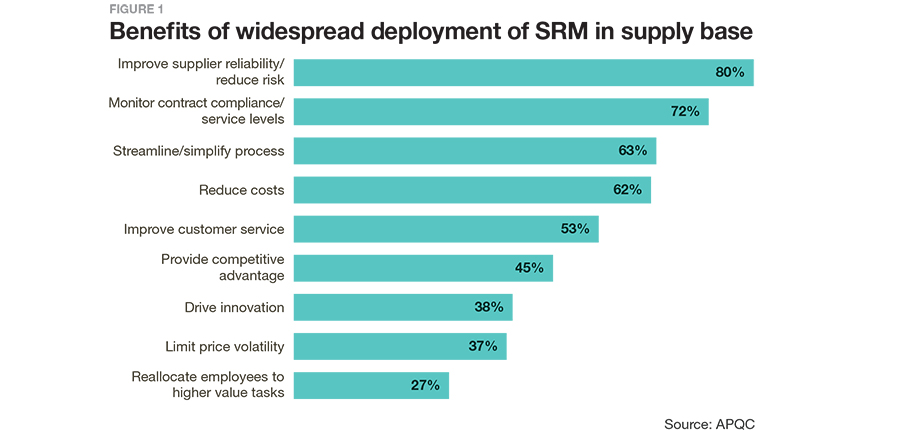Sorry, but your login has failed. Please recheck your login information and resubmit. If your subscription has expired, renew here.
March-April 2019
A few days ago, a colleague sent me “The Death of Supply Chain Management,” an article in the Harvard Business Review. If the title wasn’t enough to grab my attention, the last sentence in the first paragraph had me checking out job openings on LinkedIn: “Within five years to 10 years, the supply chain function may be obsolete, replaced by a smoothly running, selfregulating utility that ….. requires very little human attention.” Read more carefully, what the authors are really arguing is that as NextGen technologies find their place in our organizations, the role of the supply chain manager, including procurement managers, is going to… Browse this issue archive.Need Help? Contact customer service 847-559-7581 More options
Supplier relationship management, or SRM, is commonly used by organizations to ensure suppliers adhere to established contract terms and performance objectives. A recent survey conducted by APQC and Supply Chain Management Review (SCMR) revealed that most organizations are familiar with the principles of SRM, and that nearly 40% of organizations are using SRM with their suppliers to some degree. Nearly a quarter of respondents indicate that their organizations do not use SRM but are exploring its use.
Many organizations that do not use SRM intend to implement it in the near future. Although 31% of survey respondents are not using SRM, when asked about the likelihood that they will implement the approach, 68% of respondents said that it is extremely to moderately likely.
Clearly organizations consider this way of managing suppliers worth adopting. By setting measures and monitoring a supplier’s adherence to an established contract, organizations reason, they can ensure that a supplier delivers the product at the lowest cost.

This complete article is available to subscribers only.
Log in now for full access or start your PLUS+ subscription for instant access.
SC
MR
Sorry, but your login has failed. Please recheck your login information and resubmit. If your subscription has expired, renew here.
March-April 2019
A few days ago, a colleague sent me “The Death of Supply Chain Management,” an article in the Harvard Business Review. If the title wasn’t enough to grab my attention, the last sentence in the first paragraph… Browse this issue archive. Access your online digital edition. Download a PDF file of the March-April 2019 issue.Supplier relationship management, or SRM, is commonly used by organizations to ensure suppliers adhere to established contract terms and performance objectives. A recent survey conducted by APQC and Supply Chain Management Review (SCMR) revealed that most organizations are familiar with the principles of SRM, and that nearly 40% of organizations are using SRM with their suppliers to some degree. Nearly a quarter of respondents indicate that their organizations do not use SRM but are exploring its use.
Many organizations that do not use SRM intend to implement it in the near future. Although 31% of survey respondents are not using SRM, when asked about the likelihood that they will implement the approach, 68% of respondents said that it is extremely to moderately likely.
Clearly organizations consider this way of managing suppliers worth adopting. By setting measures and monitoring a supplier's adherence to an established contract, organizations reason, they can ensure that a supplier delivers the product at the lowest cost.
This is not surprising given the impact that procurement and supplier performance can have on the bottom line. What organizations neglect to consider is whether such a limited approach to managing suppliers is the best to use for all supplier relationships.
APQC, in collaboration with Kate Vitasek, Emmanuel Cambresy and Bonnie Keith, suggests a more nuanced view of developing and managing supplier relationships. APQC recommends that organizations weigh whether traditional SRM focused on cost and compliance is the best approach to use with all suppliers, instead of mainly with transactional suppliers. For suppliers that are more integral to an organization's success, provide a highly specific product, or have the potential to develop innovations that can benefit both parties, APQC recommends the development of a more strategic and collaborative relationship business model.
Benefits of supplier relationship management
When asked to consider the benefits of widespread deployment of SRM, respondents to APQC and SCMR's survey rated tactical benefits the highest. Figure 1 presents the full list of benefits reported.

Most survey respondents consider the day-to-day benefits of implementing SRM across their supply base. The most commonly held benefit is the improvement of supplier reliability—or the expectation that managing supplier performance through standard measures will motivate the supplier to perform consistently. Many organizations also consider the ability to monitor a supplier's adherence to the contract, as well as its own ability to simplify monitoring processes, to be benefits resulting from SRM.
To a lesser extent, organizations see the potential for SRM to result in additional competitive advantage, innovation, pricing control and the ability to allocate employees to higher value tasks. With many suppliers providing organizations with materials key to their mutual success, using the relationship to develop mutual benefit is far more impactful.
In fact, APQC's opinion is that traditional SRM limits both buyers and suppliers by forcing them to have a relationship focused on contract compliance and on measures related to pricing and cost. Research by the University of Tennessee reveals that it is more accurate to view sourcing business models, and thus supplier relationships, as existing on a continuum (Figure 2), with one end representing a basic provider model. This transaction-based model is best suited for traditional SRM approaches focused on price because products purchased are readily available from multiple suppliers and transitioning from one supplier to another would have little to no impact on the business. On the other end of the continuum is an equity partnership model, in which a supplier and organization invest in creating a joint venture to ensure that they can acquire or co-create mission-critical goods and services.
In the middle of the continuum are sourcing business models based on increasingly collaborative relationships, a group of models in which the buyer and supplier establish mutual goals and ultimately generate benefits for both parties. With these types of win-win supplier relationships (e.g., preferred provider, performance-based/managed services and Vested), organizations can obtain the more strategic benefits seen to a lesser extent by those organizations using traditional SRM methods across their supplier base.
Hurdles to supplier relationship management
Respondents to the survey conducted by APQC and SCMR also noted hurdles to widespread deployment of SRM for their supplier base. As shown in Figure 3, one of the top hurdles seen by respondents was a lack of a clearly defined process or methodology for managing suppliers. Over one-third of respondents also saw a lack of a guiding strategy for supplier relationship management as another hurdle.

Going beyond traditional SRM to use a sourcing business model approach with key suppliers can address the lack of methodology and guiding strategy for supplier relationship management. For supplier relationships at the relational or investment level, buyers and suppliers establish joint goals at the start of the relationship that are tied to both parties' definition of success. This provides a clearer idea of how to determine whether the supplier is performing at a level needed for a successful relationship.
Although reported by only 14% of respondents, having suppliers that are too custom, variable or short-term can also be addressed using the sourcing business model continuum developed by the University of Tennessee. In a Vested model, for example, a key supplier collaboratively defines the goals and thus the measures that fit the services provided in that unique relationship, no matter how different it may be compared to others.
Flexibility and mutual benefit
Developing the right kind of supplier relationship based on the right kind of sourcing business model moves an organization from traditional SRM to the next generation. Although it does take some time and effort to determine the most appropriate sourcing business model to use and then develop a collaborative relationship that benefits both parties, the payoff does exist for organizations that look beyond the traditional approach for managing supplier relationships.

Real-life examples exist of how organizations can re-evaluate and adjust their supplier relationship management. Swedish telecom company Telia Co. AB evaluated its suppliers to determine which would be good candidates for a Vested sourcing model, a relational model in which both parties enter into a collaborative relationship that creates value for both. This partly involved determining which suppliers would be considered experts in their field, meaning that these suppliers would not need to be micromanaged on how they achieved their objectives. Dell worked with its reverse logistics provider FedEx Supply Chain to shift to using a Vested sourcing model with outcome-based measures focused on transforming processes. The decision to go this route was made after both parties realized that keeping a sole focus on cost was damaging their buyer-supplier relationship and was no longer leading to new savings.
One benefit to viewing sourcing relationships on a continuum is that organizations can re-evaluate the relationship with a given strategic supplier as circumstances change. As with Dell, an organization looking to shift the nature of a relationship can easily do so by comparing the current sourcing business model used with the supplier to models further along the continuum.
Not only does this approach benefit the business overall, but also staffing levels for sourcing and supplier management. By sorting the more transactional relationships from those that are more collaborative and strategically focused, the organization can allow staff to focus their efforts on relationships that require more attention.
About APQC
APQC helps organizations work smarter, faster, and with greater confidence. It is the world's foremost authority in benchmarking, best practices, process and performance improvement, and knowledge management. APQC's unique structure as a member-based nonprofit makes it a differentiator in the marketplace. APQC partners with more than 500 member organizations worldwide in all industries. With more than 40 years of experience, APQC remains the world's leader in transforming organizations. Visit us at apqc.org, and learn how you can make best practices your practices.
SC
MR


Latest Supply Chain News
Latest Podcast

 Explore
Explore
Business Management News
- U.S.-bound containerized import shipments are up in June and first half of 2024
- Expand supply chain metrics to cover the complete customer experience
- When disaster strikes, the supply chain becomes the key to life
- Leadership development for supply chain leaders
- A smarter approach to sustainability is vital for healthy, resilient supply chains
- When the scales tilt: Making vaccine access work for all
- More Business Management
Latest Business Management Resources

Subscribe

Supply Chain Management Review delivers the best industry content.

Editors’ Picks





